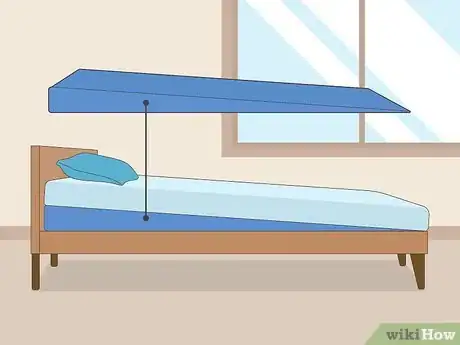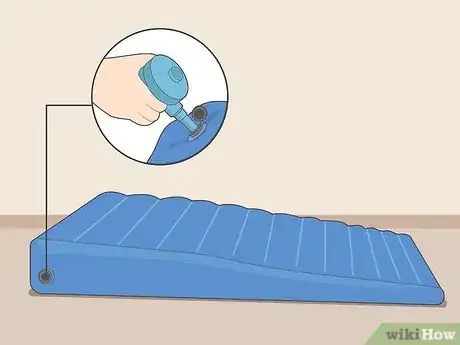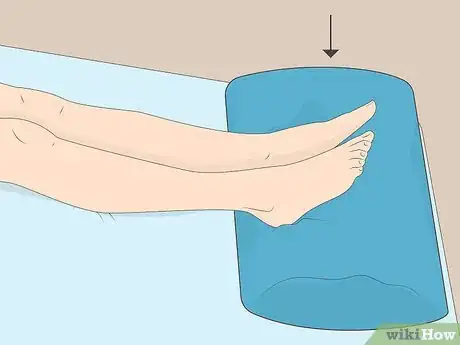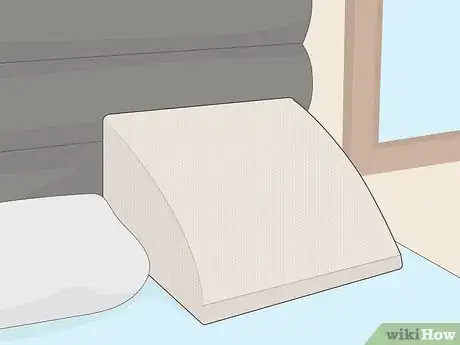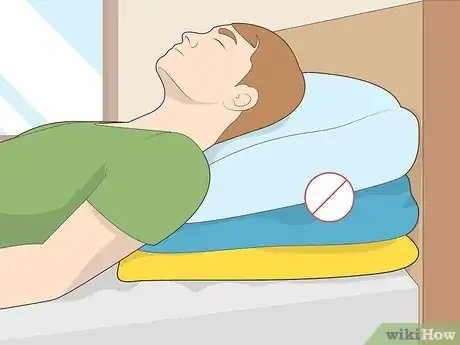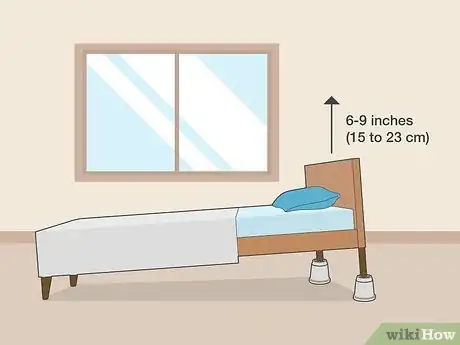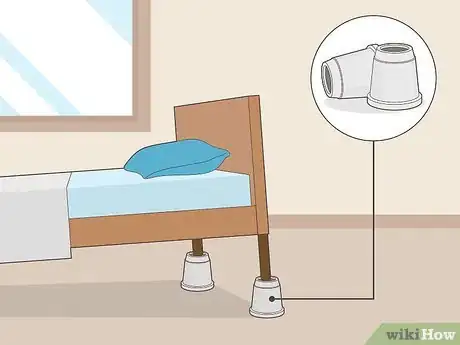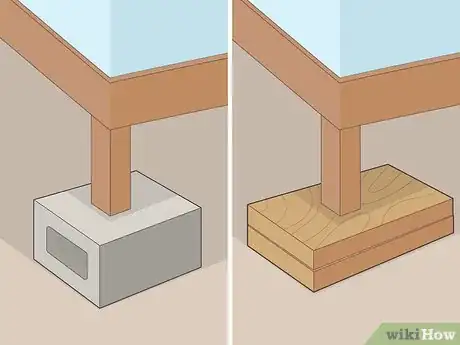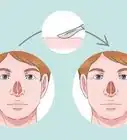This article was co-authored by wikiHow Staff. Our trained team of editors and researchers validate articles for accuracy and comprehensiveness. wikiHow's Content Management Team carefully monitors the work from our editorial staff to ensure that each article is backed by trusted research and meets our high quality standards.
This article has been viewed 309,750 times.
Learn more...
Elevating the head of your bed can help relieve snoring, sleep apnea, acid reflux, and supine hypertension or orthostatic hypotension.[1] Bed risers are a good, inexpensive option, and there are products specially designed to raise one end of the bed. Basic risers aren’t quite as secure, but are about half the price. Other solutions, from most affordable to most expensive, include wedge pillows, bed wedges that fit between the mattress and box spring, and inflatable mattress overlays. If you haven’t already, consult your doctor about finding solutions for any chronic medical condition.
Things You Should Know
- Place a bed wedge under the head of the mattress for a quick and easy option. You can also try using a wedge pillow.
- Invest in an inflatable mattress overlay for a versatile solution, especially for a guest bed that needs to accommodate different sleepers.
- Use bed risers to safely elevate the head of the bed 6 inches (15 cm) or more.
Steps
Using Pillows and Mattress Pads
-
1Buy a bed wedge to place under the mattress. Bed wedges are foam inserts that fit between the mattress and box spring. At $50 to $100 (U.S.), they’re more expensive than most wedge pillows. Some people prefer them because they elevate the entire end of the mattress and reduce the chances of slipping down in the middle of the night, which is a common complaint of wedge pillow users.[2]
- You can purchase multiple three inch wedges to gradually increase your mattress elevation so you can get used to the additional height.
-
2Invest in an inflatable mattress pad. Aside from getting an adjustable bed, a mattress overlay is your most expensive option. You might prefer an inflatable overlay if you don’t like the look of a permanently elevated bed. You can deflate the pad during the day so the bed appears normal.[3]Advertisement
-
3Place a large pillow at the foot of the bed to prevent sliding. Sliding down the bed is a common complaint, particularly among users of wedge pillows. Placing one or more large pillows at the foot of the bed will help you stay elevated and prevent overnight sliding.[4]
- If you’re having sliding problems, you can also try swapping silk or satin sheets for a less slippery material, like flannel.
-
4Purchase a wedge pillow. You can find wedge pillows online, at drugstores, and at medical supply stores.[5] On average, they cost around $40 (U.S.). If you suffer from acid reflux, you can also find wedges with arm inserts to promote a comfortable side sleeping position.[6]
- Sleeping elevated on the left side is recommended to ease the symptoms of reflux disease.
-
5Avoid just using piles of pillows. Stacking ordinary pillows isn’t an effective way to treat sleep apnea or acid reflux. It can actually worsen your symptoms by placing your body in an unnatural position. Further, it can cause neck pain and spinal misalignment.[7]
- It’s best to use a wedge or elevate the entire bed in order to ensure the head, neck, and chest are all elevated properly.
Using Bed Risers
-
1Raise your bed at least six inches (15 cm). Elevating the head of the bed by six to nine inches (15 to 23 cm) is recommended for both sleep apnea and acid reflux.[8] You should still be comfortable enough to get a full night’s sleep, so try starting at a lower elevation instead of going straight to nine inch risers.
-
2Install risers designed to elevate one end of a bed. Specially designed risers will lower the risk that the bed will slip and collapse, so they're your safest option. They look similar to normal risers, but have non-slip bases and wells with foam inserts that adjust to the bed feet. To install them, have someone help you lift the bed, then insert the feet into the wells, or the depressions at the risers' tops.
- When you stick a bed foot into the riser's well, the foam insert will mold to the foot's shape.
- You can find specially designed risers online or at a nearby home improvement store. At around $15 (U.S.), they’re more expensive than basic risers.
-
3Use wood, metal, or heavy duty plastic risers with wells. Basic bed risers cost about half as much as specially designed products. However, they don’t have foam that molds to the angle of the feet that results from elevating one end of the bed. If you do go with a basic product, it should still have wells or recesses so the bed feet don’t slip over the edge.[9]
- Avoid lightweight plastic products, as they’re not as safe as thick, heavy duty plastic, solid wood, or metal options.
-
4Go with cement or wood blocks for the most affordable option. Cinder blocks, stacks of wood, or even thick books are your cheapest option.[10] While inexpensive, these options aren’t as safe as store-bought bed risers, and many people don’t like how they look. In addition, it might be more difficult to ensure you’re raising the feet to the same height.
- Choose the widest blocks possible to reduce the risk of the feet slipping. You can also place non-slip pads, such as those you'd use to keep a rug from moving, under and on top of the blocks to reduce the risk of slipping.
- One pro is that you can start from a low height and gradually stack more books or blocks until you reach six to nine inches. That way, you can get used to the elevation without having to purchase multiple sets of bed risers.
References
- ↑ https://www.ncbi.nlm.nih.gov/pubmed/27250962
- ↑ https://refluxmd.wordpress.com/elevation-therapy-for-acid-reflux/
- ↑ https://refluxmd.wordpress.com/elevation-therapy-for-acid-reflux/
- ↑ https://www.healthcentral.com/article/acid-reflux-elevating-the-head-of-the-bed-can-help
- ↑ https://www.healthcentral.com/article/acid-reflux-elevating-the-head-of-the-bed-can-help
- ↑ https://refluxmd.wordpress.com/elevation-therapy-for-acid-reflux/
- ↑ https://my.clevelandclinic.org/health/articles/gastroesophogeal-reflux-disease-gerd
- ↑ http://www.mayoclinic.org/diseases-conditions/gerd/basics/lifestyle-home-remedies/con-20025201
- ↑ http://inclinedbedtherapy.com/faq/methods-of-raising-a-bed-for-inclined-bed-therapy/102-plastic-furniture-bed-raisers-risers-for-inclined-bed-therapy
About This Article
To elevate the head of a bed, purchase a wedge pillow online or at your local department store to raise your head safely. If you’re worried about sliding down the bed during the night, place a large pillow at the bottom of the bed to prevent this. Another option is to buy a bed wedge, which you place between the mattress and bed springs to raise the entire mattress at one end of the bed. Alternatively, place wide cinder blocks or thick books under one end of your bed to raise it by up to 6 inches. Avoid piling several normal pillows on top of each other to elevate your head, since this can lead to neck problems due to you sleeping in an unnatural position. For tips on how to install a bed riser, read on!
